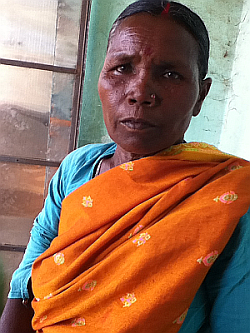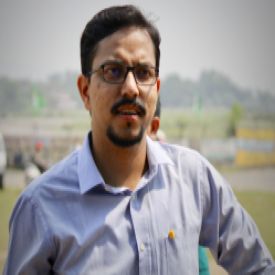As part of a special three part series, the Prime Minister’s rural development fellows bring us voices from the field about what development means to women in some of the most remote parts of the country. What is the impact of government programmes on the day to day lives of the people they are supposed to help? The first account in this series is of Kajalmani Soren in Lalgarh, West Bengal. Coming from a family of landless labourers, she talks about her experience with the National Rural Health Mission, the Employment Guarantee Scheme and the Public Distribution System.
She sits still on the wooden bench, with a calm disposition, hardly bothered about the heat outside. It is midday and the occasional passenger bus stops outside the Satpati Health Sub Centre where Kajalmani Soren waits patiently to get an X-Ray for her right wrist.

Soren, around 50, belongs to Chandabila village in the Dharampur Gram Panchayat of Lalgarh - a strong bastion of the Maoist movement during 2008-2010 in West Bengal. In the summers of 2010, a couple of her neighbours, both members of the CPM, led Panchayat were killed by the Maoist cadres on allegations of being police informers. The Maoist movement has now lost its steam and a stream of development initiatives have been started by both the central and state governments in ‘Jungle Mahal’, an oft-mentioned name for these remote tribal areas spread among the thick cover of Sal, Piyal and Mohul forests.
"Our daily lives are tough but we try to live through our hardships. Being landless agricultural labourers, (we) survive on the money received from the agri-labour work done in the area and sometimes in other villages", says Soren while describing how she had to borrow money from others in the village to marry off her daughter a decade ago. While the daughter now visits them with her children, they are still paying off the loan in occasional instalments. Over the last decade the only visible change that Soren observes is of rural connectivity. "Before my daughter's marriage, even visiting the Block Office at Lalgarh1 for any need was beyond our imagination. Now we even have motor bikes and big cars entering our village", she says slowly though her family doesn’t even own a bicycle. While having a handful of muri (puffed rice), her only meal since morning, she regrets having married off her daughter at the tender age of 15. She readily blames it on her ignorance and illiteracy.
In an act of redemption, she now wants to make sure that her daughter does not repeat her mistake. "My granddaughters go to school, eat the mid-day meal", she says elatedly.
Meanwhile the X-Ray technician at the Mobile Medical Camp is ready; she lies down on the bench, hesitant initially. Ask her why and she says with embarrassment, "I have never done any photo before". Her only way to reach a doctor is to travel to the nearest Health Sub Centre at Dharampur, 4 kms away from her village. For Kajalmani and most others in the nearby villages, a private village doctor Mahato, as he is called, is their only hope. An initiative under National Rural Health Mission (NRHM), Mobile Medical Camps in ‘Jungle Mahal’ have been operating every week at selected Gram Panchyats in these far flung areas to provide basic access to curative and diagnostic treatment to the large tribal population. She was but unaware of it till her brother-in-law Kunaram Murmu drove her down to this centre at the adjoining block Salboni for a check-up. As she speaks Santhali and just understands some Bangla, Kunaram has been translating her words.
We have some more time till the X-ray report is being generated. She asks me about the process to receive Mahatma Gandhi National Rural Employment Guarantee Act (MNREGA) wages on time and I fumble for answers. More queries reveal that although her household has an MNREGA Job Card, she has worked for only six days over the last few years.
"I have to stay back to look after the couple of cows and hens - that is our only stable source of income", she chips in. Her husband though goes for work only when 'he is asked to join work at any job-site'- the preferred practice in most of these remote areas. She admits there has been an increase in the overall income with MNREGA work but that it is quite irregular. I inform her about the increase in MNREGA wages from April 2013 onwards but it does not seem to interest her much. I ask her about her participation in Gram-Sabhas. She looks strangely at me, seemingly oblivious of the term.
"The community is pretty introvert and hardly anyone expresses anything to the Panchayat representatives", informs Kunuram Murmu, her brother-in-law, a social worker and community organiser. I explain to her the importance of communicating demands and needs to the Panchayat functionaries. She silently nods her head.
Her X-Ray report arrives; there is a small ligament tear on her right wrist. She takes the medicines, listens to the doctor's advice and then silently walks away. While her brother-in-law moves ahead towards the parked motor bike, I join her on the 100 meter stretch. I ask her about food supplies under the Public Distribution System (PDS) and Below Poverty Line (BPL) cards. Suddenly her face lights up and she signals with her fingers. I decipher the code: it's the Rs. 2/ kilogram of rice scheme that is provided to all BPL families in ‘Jungle- Mahal’. "They also receive kerosene, flour and oil at the PDS. But it's the rice that matters to them', adds Kunaram while taking a sip from a nearly crushed water bottle.
Kajalmani owns neither a TV nor a radio. Back from this rare venture into the outside world, she will now be going back to the fields with the cows and look after them. At day break, she may probably sit down and separate the small pebbles from the rice and lentils to be cooked for dinner. Kunaram urges me to visit Kajalmani's village sometime. I nod in consent and wish Kajalmani a quick recovery from the wrist pain. She smiles faintly and says that next time a Panchayat member visits her village; she will surely voice her needs and demands.
Kunaram's motor bike takes the road towards Lalgarh while a small group of CRPF men in olive fatigues and black bandanas patrol the roadside. At present, there is peace in ‘Jungle Mahal’ but till the time Kajalmani and many others of her ilk are not made active participants in the process of development, the road ahead is going to be tough.
Next Friday read about Bahrin Bhuyinya’s life in Jharkhand, and her views on Naxalism and the changing role of women in the village community.
Notes:
- Lalgarh is approximately 18 kms from Chandabila, where Soren lives.




 28 June, 2013
28 June, 2013 




Comments will be held for moderation. Your contact information will not be made public.